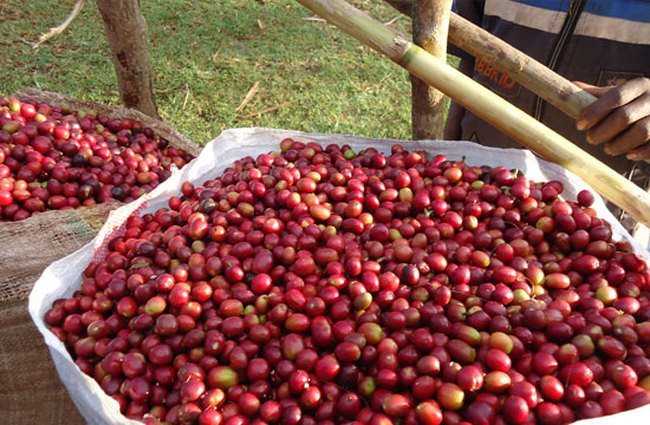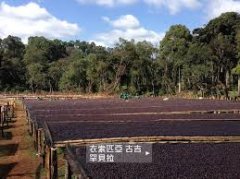Esselbella single layer stack provides the perfect convection and dry environment for coffee cherries.
For professional baristas, please follow the coffee workshop (Wechat official account cafe_style)

Slow drying of single floor on a single farm in Humbela Manor, Ethiopia [Holy Lion]
121 batches of solarization & 105 batches of water washing
Ethiopia Hambela Benti Nenqua G1 SFP SLD
Natural Lot 121 & Washed Lot 105
(30KG small gunny bag with GP plastic inner bag)
Intellectuals choose and sell at the same time!
Country Ethiopia (Ethiopia)
Producing area Oromia Region
Guji (Guji Zone)
Humbela (Hambela Woreda)
Holy Lion Village (Benti Nenqua Kebele)
2150 m above sea level (GPS measured height of the processing plant)
Variety Isabia Guyou original species (Heirloom)
The annual rainfall is about 1500-2000 mm
Treatment plant Humbela (Hambela)
GPS N5 °55 & # 39 * * 9 "E38 °33 & # # 39 * 44"
Treatment method of African scaffolding single layer slow sun drying treatment & water washing treatment
It can be said that this series is the sister production of 118 batches of Godibe Sun drying and 008 batches of water washing. it is also a series of works that we try to enter the next generation in Ethiopia with you. (please refer to the special article introduction of http://facebook.com/PebbleCoffee/posts/691098514386837.
The name Benti Nenqua comes from Oromo Language, the native language of the Oromer people (* Oromo People, see note) of the district since ancient times, which means Virgin Lion, which is now the name of a village (Kebele) in the area. In ancient times, this fertile soil was covered with a dense forest, which was the lion's habitat, hence its name. Under the name of this batch, when the editor is tested in the cup, apart from enjoying the charm in the cup, thinking about its origin, the changes of time over the ages, and the complex and ever-changing national situation in Ethiopia, compared with the recent turbulent situation in Ethiopia, it really feels like vicissitudes of life, and the aftertaste is endless.
This product comes from Hambela Manor. The owner of the estate, Aman, was educated in the West and had complete experience in Western enterprises. What is even more amazing is that after returning to Ethiopia, he served as the Chief operating Officer (Chief Operation Officer) of ECX before setting up his own coffee production company. Based on the principle of neutrality in official organizations, he was unable to intervene in production or business during his tenure, and finally showed his ambition after stepping down from his post. A total of two sites have been selected in Isobe, one of which is the best-selling 118 batches of slow drying on the single floor of Gedeb single Farm, and the second and most important is this Humbera estate.
Humbera Manor is located in the Guji district. The rise of the Guji district can be said to be one of several important development trends in Ethiopia in recent years. Shakisso is a well-known example, but it can be said that the mode of operation of Humbera Manor is completely different. According to the experience of our actual visits, the rise of Guji District can be said to have its inherent conditions, but the journey to visit this producing area is also more difficult.
Before we went to Guji, we had been fooling around in Ethiopia for a while. In addition to being physically exhausted, we also caught a cold and a high fever on the same day. It is said that there is a fever, in fact, it is also based on feeling, because there is no thermometer to measure. Knowing that he had to go through Yega Chefe on his way back, and believing that his condition was getting better, the editor made an even more wrong decision. He left most of his luggage at his friend's house and set off light. The small luggage also used too much space to fill the camera, lens, and tripod to expose an equatorial star orbit. Most of the most important warm clothes were left in Yega Chefe, which almost had holes in the head. During this trip, we have already got a sim card from Ethiopia. We usually surf the Internet and browse FB to see what customer complaints have recently been reported. The Internet speed is still working. Unexpectedly, the signals in Guji are all zero, so I can't even send a message. I lost contact at all. Fortunately, God is blessed to come back alive to send this crap, so that you can share this stupid journey.
To get to Humbera Manor, you must pass through almost the entire Yega Chevy producing area, drive south from the town of Yega Chefen, pass the fork leading to Kochere or Chelelektu, take the left path to the southeast, and turn left before reaching the town of Gedeb to prepare to set foot on Gucci, where the left intersection is almost more than an hour away from the town of Yega. Shortly after the eastward journey, we will leave Gedio Zone (SNNPR Region) and enter Guji Zone (Oromia Region). On this road, the air was cool, the smoke curled, and the altitude was very high. We also took a few pictures of shuttling through the clouds to experience the scene together. The editor may have a fever plus relationship, and soon fell into a state of half-sleep (but still sleepy again on the return trip). When he woke up several times, the GPS measured the altitude above 3000, and several times he walked on the road of the mausoleum line to get into the mountains, and the scenery was magnificent besides a dream.
After several bumps, we finally arrived at Humbera Manor at an altitude of 2150 meters. Along the way, we passed through many primeval forests, and there was still a large area of land that had not been developed. Even the newly developed farmland in the manor retained the primeval forests to a great extent and struck a natural balance with the environment.
Harvesting and selecting fully ripe bright red cherries is already the most basic (let us remind you that this is very difficult to achieve in Ethiopia, which is dominated by a smallholder system, and generally can only rely on hand-picked work on the scaffolding). The sun treatment here uses the most stringent and exquisite work, so the cherries on the scaffolding are only one layer thick, and the drying schedule is strictly controlled at about 18 days, so we gave him a simple name (SLD-Single Layer Drying/Slow Drying). The single-layer stack provides the most perfect convection and dry environment for coffee cherries, which is well known, but it is the most space-consuming and unfavorable mode of production. Proper slow drying can make coffee cherries develop the best water activity during the drying process, which not only develops the flavor better, but also allows the storage of raw beans in the production season to last longer, but again, this way prolongs the time required for each batch of production, using such a drying process, not only depends on the weather to eat, but also the producers are willing to put in. Not only are we fascinated by Aman's insistence on coffee quality, but even third-wave operators in Europe and the United States, such as intellectuals (Intelligentsia), Klach, Barrington and so on, are bound to choose beans every year. In March 2016, Barrington got an excellent score of 96 Coffee Review by washing beans with Hambela.
[sun Flavor short Review]
Rich tropical fruit flavors, complex floral aromas, aromas of citrus and Phoenix pear juice, sweet aromas of peach, passion fruit and strawberry jam. The tail is rich in charming floral aromas and fresh blueberries.
[brief comment on washing Flavor]
The sweet bouquet of egg blossoms, lemon, lime, citrus, exotic juice aromas, middle and finish for elegant blueberry, strawberry aromas and sweet and sour, solid overall sense of peach, honey sweet taste.
Oromo People is the largest indigenous people in Ethiopia, with a population of about 38 million, accounting for about 40% of Ethiopia's total population. Its mother tongue is called Oromo Language. Oromo is a nation / word, because it occupies a certain place in the population and history of Ethiopia, so we can often see words with Oromo as the root. For example, the largest administrative Region in Ethiopia is Oromia Region across the Great Rift Valley (Great Rift Valley). Today, the largest coffee cooperative organization in Ethiopia is Oromia Coffee Farmers Cooperatives Union (OCFCU). The last emperor of Ethiopia, Haile Selassi, was purely in terms of lineage, and the Auromo lineage was the largest (though he ascended the throne mainly because of his grandmother's royal lineage, the Amara Amhara lineage, whose national language is now the Amara language Amharic).
Important Notice :
前街咖啡 FrontStreet Coffee has moved to new addredd:
FrontStreet Coffee Address: 315,Donghua East Road,GuangZhou
Tel:020 38364473
- Prev

The typical self-sufficient Manor of Panamanian Love Sage won the championship? Super Jadeite Manor
Professional coffee knowledge exchange more coffee bean information please follow the coffee workshop (Wechat official account cafe_style) (photo source network) Panama (Panama) first-class coffee is grown in the western part of the country, that is, near Costa Rica, near the Pacific Ocean. The Boquet district of Chiriqui province is the most famous for producing coffee, such as Wakan, Santa Clara, Kendra, etc.
- Next

The reason why Humbela Manor in Ethiopia has won the high score of Coffee Review and the way of terrain harvest
Professional barista exchanges please follow the coffee workshop (Wechat official account cafe_style) Ethiopia washed Humbera Manor Benti Nenqua single farm slow drying 105 batches of flavors: sweet flower aromas of egg blossoms, lemon, lime, citrus, exotic juice aromas, middle and finish for elegant blueberry, strawberry aromas and sweet and sour, solid overall feeling
Related
- Does Rose Summer choose Blue, Green or Red? Detailed explanation of Rose Summer Coffee plots and Classification in Panamanian Jade Manor
- What is the difference between the origin, producing area, processing plant, cooperative and manor of coffee beans?
- How fine does the espresso powder fit? how to grind the espresso?
- Sca coffee roasting degree color card coffee roasting degree 8 roasting color values what do you mean?
- The practice of lattes: how to make lattes at home
- Introduction to Indonesian Fine Coffee beans-- Java Coffee producing area of Indonesian Arabica Coffee
- How much will the flavor of light and medium roasted rose summer be expressed? What baking level is rose summer suitable for?
- Introduction to the characteristics of washing, sun-drying or wet-planing coffee commonly used in Mantenin, Indonesia
- Price characteristics of Arabica Coffee Bean Starbucks introduction to Manning Coffee Bean Taste producing area Variety Manor
- What is the authentic Yega flavor? What are the flavor characteristics of the really excellent Yejasuffi coffee beans?

